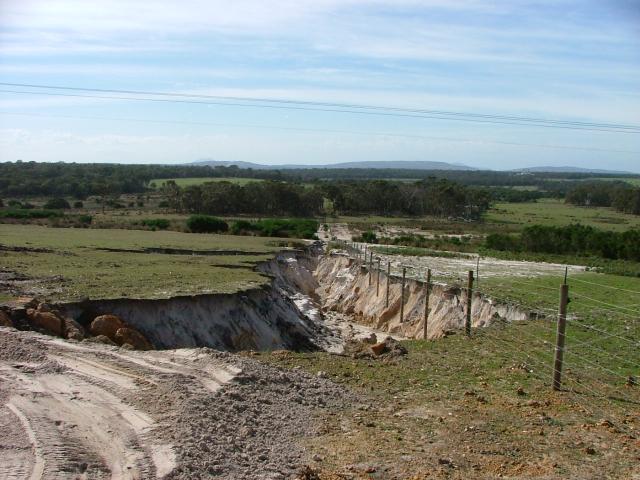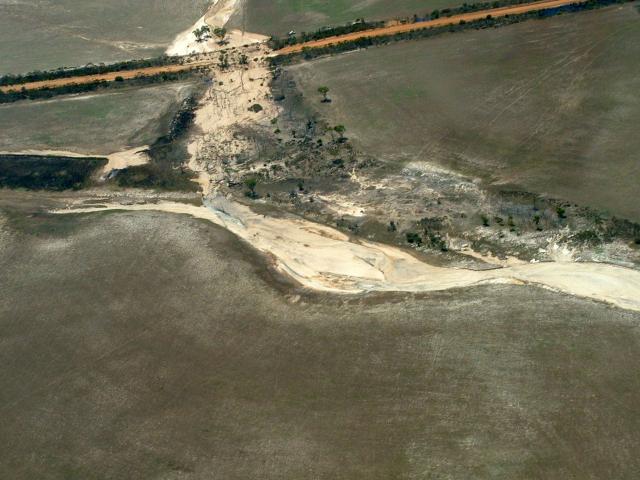Water erosion causes on-farm and off-farm damage
Water erosion can:
- remove or move nutrients
- remove valuable topsoil, which might reduce effective rooting depth and plant available water
- deposit silt in dams, waterways and lowlands, which can make flooding and waterlogging even worse
- produce rills and gullies that reduce trafficability of paddocks
- damage tracks, fences and infrastructure on farm and off farm (Figure 1).

Reducing the risk of water erosion
Water erosion can be reduced or prevented in most years and situations with a combination of engineering, chemical and vegetative measures. Water erosion in severe storm conditions is much harder to prevent.
Options include:
- install surface water earthworks
- maintain vegetation cover
- restrict livestock access to susceptible areas
- manage firebreaks
- minimise soil detachment and maintain stable soil.
Install surface water earthworks
Surface water earthworks can reduce water erosion by intercepting, diverting or slowing run-off, rather than permitting it to flow uninterrupted down the slope.
Managers can reduce the risk of water erosion by controlling surface water run-off with conventional grade banks or broad-based grade banks, and by using cropping and cultivation systems that build up soil structure and minimise exposure of bare soil. These options are more effective when combined with crop stubble retention, retained pasture cover, and management of vehicle and livestock disturbance.
Grade banks control water run-off by increasing the length of the flowpath, thereby increasing time of concentration and slowing the velocity (speed) of the run-off. Grade banks are placed in mid- and upper-slope water-shedding landscapes. To be most effective, grade banks should be deep enough to allow the subsurface clay to be cut and placed on the downhill bank to provide a seal against seepage. Broad-based grade banks suit cropping areas, especially in combination with controlled traffic farming.
Roaded catchments and dams can, in addition to storing water, provide some buffering or retention of surface water flow if grade banks are linked into them, such as within a ‘keyline system’. Grassed waterways can also be used in some instances.
Maintain vegetation cover
We recommend maintaining at least 70% vegetated groundcover (pasture, crop or stubble) on areas susceptible to water erosion, to protect the soil surface from moderate surface water flows. We also recommend permanent, complete (100%) vegetated cover for grassed waterways and susceptible valley floors.
Use upslope interceptor vegetation (windbreaks, tree belts and native vegetation) together with surface water earthworks to prevent long runs of surface water.
Restrict livestock access to susceptible areas
Reduce stocking rate or remove livestock from areas likely to erode. Grazing will remove groundcover (increasing exposure) and loosen the soil surface (increasing erodibility). Storms during summer and early autumn often have highly erosive rainfalls, which can result in serious water erosion on bare, loose soil.
Manage firebreaks
Firebreaks are a common starting area for erosion. Most firebreaks follow fence lines and act as laneways, which means erosion is likely to cause fence damage and reduce vehicle access.
Use herbicides for firebreaks rather than ploughing or discing. Leaving the soil undisturbed (lower erodibility) is especially important on steep slopes. On long firebreak-runs downslope, we recommend small diversion banks or the start of grade banks to intercept and redirect surface water.
Maintain stable soil condition
Maintain a good soil structure by preventing soil disturbance (cultivation or livestock movement), improving soil structure by applying gypsum to soils susceptible to dispersion, or improving the soil organic matter content (e.g. through deep-rooted perennials and reduced cultivation).
Where is water erosion a risk?
This topic is covered in the water erosion chapter of the Report card on sustainable natural resource use in agriculture.
The level of risk (likelihood by impact) is increased by:
- steep and long slopes, and water accumulation areas
- susceptible soil type
- intense prolonged rainfall and high volumes of surface water flow
- exposure of the soil to rain
- looseness of the soil surface
- value of the land use.
Simple monitoring can help identify areas at risk:
- where vegetation ground cover is less that 50%
- sheep camps and overgrazed patches have loosened soil and little ground cover
- where water flows after heavy rains
- previous areas of water erosion.
Taking photos of at-risk areas each year, and then comparing across a number of years, can identify slow changes in the landscape.
Regulation and legislation
Poor design and construction of earthworks can cause, rather than prevent, soil degradation. Diverting water flows and increasing flow velocities or volume could cause damage to neighbouring properties, for which the drainage proponent may be responsible under Common Law, and the degradation can be covered under the Soil and Land Conservation Act 1945.
We recommend discussing planned earthworks with any neighbours that may be affected, and consulting suitably qualified people about legal aspects, design and construction.
Types of water erosion
Sheet erosion
- Sheet erosion occurs as a shallow 'sheet' of water flowing over the ground surface, resulting in the removal of a uniform layer of soil from the soil surface; often appears as small sediment deposits behind tufts of grass.
- It can occur during severe storms. It often affects areas where the soil surface lacks sufficient protective vegetation cover and there is some land slope.
- It contributes to rill erosion where the concentration of surface water run-off flows into deeper, faster moving channels (or rills) which follow low points through paddocks (Figure 2).
- It is often responsible for extensive soil loss in cultivated and non-cultivated land.
Rill erosion
- Rill erosion is caused by soil detachment from concentrated run-off.
- It comprises numerous small channels of less than 30cm depth.
- It can occur with sheet erosion, and is commonly seen in paddocks that have been recently cultivated or overgrazed prior to intense rainfall (Figure 3).
- It results in the loss of topsoil, organic matter and nutrients and significantly affects paddock productivity and water quality.
- If shallow, the rills can be removed by cultivation.
Gully erosion
- Gullies are deep (>30cm), open, incised and unstable channels, sufficiently large to disrupt normal farming operations (Figure 4).
- Gully erosion is a severe form of land degradation, affecting infrastructure, paddock management and property access.
- Rehabilitation of gully erosion is complex and expensive. If you have serious gully erosion, we recommend you seek advice before trying to fix the problem.
- See repairing gully erosion for detailed information.

Tunnel erosion
- Tunnelling is uncommon in Western Australia, except in dispersive clays. Surface water flows into a dispersive subsoil through surface cracks, rabbit burrows, or old tree root holes, resulting in the subsoil slowly etching away (Figure 5). Tunnel erosion is sometimes seen in dam walls constructed of dispersive clay.
- Once formed, tunnels continue to enlarge during wet periods, eventually reaching a point where the tunnel roof collapses resulting in potholes or sinkholes and the formation of gullies.
- Fencing susceptible areas, diverting run-on water flow, increasing upslope (interception) vegetation cover and applying gypsum are some of the methods for managing areas affected by tunnel erosion.

For more information:
See the linked pages or contacts below.



